Copyright Notice: This article is Copyright AI Factory Ltd. Ideas and code belonging to AI Factory may only be used with the direct written permission of AI Factory Ltd.
Gothic 3 was a PC project created by the German developer Piranha Bytes, and released by Jowood in 2006. We were part of a tender to port this to Xbox, which finally never actually happened, but we picked the product up on the way and become familiar with it. One of the major issues was that this ambitious game was released with very serious bugs which made it totally unplayable on many hardware configurations. In consequence, although nominated best game of E3 by IGN, it unfortunately initially suffered rather badly in review.
We normally never talk about other developer products, but this time we have made an exception. This article pays tribute to this great product we came close to being involved in.
Open Worlds: The perfect goal?
Having personally been exposed to early games such as Morrowind I had begun to realise that maybe we were not so far off seeing the holy grail of a truly open world product. It is a matter of individual taste, but games with fixed paths that mimic the feeling of a free world do not cut it with me. As soon as I try and wander off towards a bush and find I have hit some imaginary wall, the sense of disbelief and immersion totally collapses.
Other nearer "free world" games offer a trail of breadcrumbs to lead you through a pre-determined linear script, just giving the illusion of a free world, but by trickery. Again not really good enough.
It appeared that Gothic 3 might genuinely fill this "free world" role. It certainly looked good, which was a great starting point:

The Play History
As released, Gothic 3 was a total disaster on my own PC. After about 30 seconds play my character would start to fly and disappear over the ocean. The next patch was better but some 15 minutes play and game was over as you became stuck in some scenery or something else truly horrible happened. The general reputation of the product suffered, gaining some good reviews but panned by others, because of the instability. As it turned out these were not just technology bugs but also game bugs which made parts of the game unplayable. The developer Piranha Bytes provided patches, ending with 1.12, after which they abandoned it because of a dispute with the publisher Jowood.
That was not the end of the product though as the publisher Jowood released the sources to the game community to fix. Such was the aspiration and huge belief of the community that these became a well-organised and committed group, collectively known as "The Community Patch" and quickly patch updates became available. The last 1.5gig patch by this group was released as late as 2012, some 6 years after the original product release(!).
They did a fabulous job, finally realising the aspiration of the original ambitious product. The product was eventually re-released by Mad Vulture games as the "Enhanced Edition", with follow-on versions.
Following on the coat tails of this group I snapped up an early community patch and dug into this huge world that Gothic 3 provided. After about one year's play (I tend to explore absolutely everything) I had explored some 33% of the world. I then realised that there were much better later patches out there, but that these were not compatible with old saves.
I bit the bullet and started the game all over from scratch, gaining in that I had figured how to play better. Although perhaps faintly shocking, I am still playing this game now, constrained a little by the limited time I can spare for gaming.
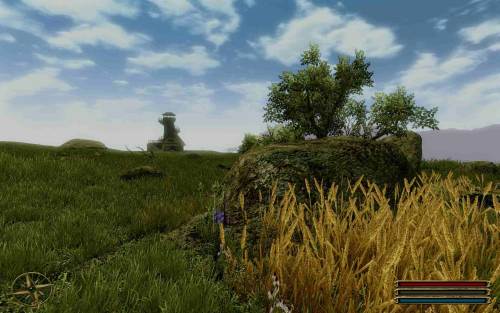
Why am I still Playing?
So how come a virtual world created nearly a decade ago could still have any attraction? Very clearly within this period the quality of the rendered worlds has somewhat moved on, so Gothic 3 must look very lame tech by now? However it should be noted that when Gothic 3 was released that the available top-end hardware was scarcely enough to play this technically demanding game, so that really it was arguably released before what should have been its time. It took a number of years for the hardware to be able to catch up and deliver a reasonable game for the regular gamer.
However there is more to it than that. There is a more to a game than tech capability and Gothic 3 did very well within the tech it exploited. It scores on a number of fronts:
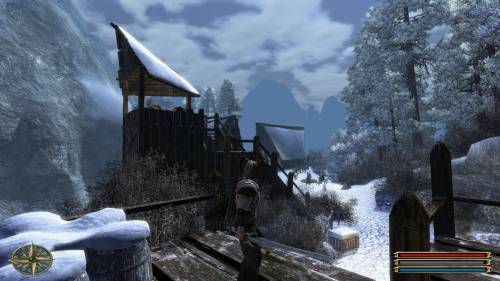
1. Scenery quality and richness
To work you need to be able to look at the world and feel it is beautiful, intriguing and believable. At some keynote I gave a while back I pinged a question to the audience to see if anyone knew about how this world was created. Apart from the high believability of the scenery at each point, it managed to never seem to be formulaic. When you crossed a hill or wandered through a wood it did not feel as-if you were seeing re-arranged versions of what you saw before. Each nook and cranny felt unique. Of course there were recycled objects, such as teapots which popped up all over, but that is ok. This richness made me want to explore every inch of this huge world. The scenery was indeed beautiful.
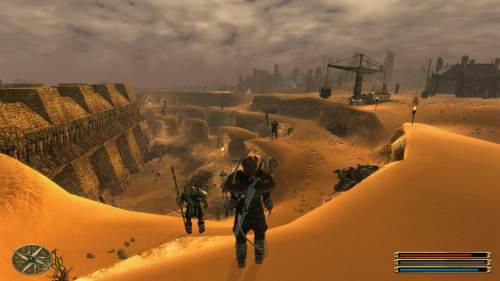
2. Seamless Play
At the time of Gothic 3 release the product Oblivion was also on release and doing well. I bought this but gradually dropped out of playing it. An issue for me was that Oblivion is partitioned into many multiple sub-worlds. Entering a building takes you through a loading screen before you entered. This convenient tech shortcut somewhat breaks immersion.
Gothic 3 instead gives you just one world, so you could edge into a building and look inside and outside at the same time. That is technically very challenging as you need to cache very complex sets of model data and juggle these in a manner that allows you to effectively render any possible viewpoint.
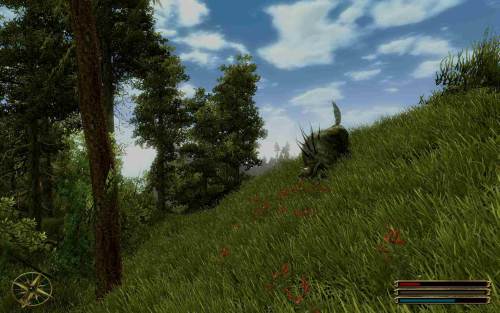
3. Game play that feels very close to a true Open World
The game is dotted by many sub-quests that the player can use to gain experience, but beyond that the player can do as they please. The world has 6 main factions, 3 of which have goals to take over the world: The Orcs, Hashinin and the Rebels. The player can interact and double cross these factions for their gains, but there is no actual obligation to work with any of them and instead the player can remain a free agent, pursuing their own goals, and progressing and exploring as they choose.
Villages you encounter appear to be real. They are not devoid of inhabitants and appear to be running their own lives. The world runs without your intervention. Peering into the distance you might spot some conflict between goblins and orcs, or any other such interaction between game entities. Such a conflict might offer some opportunity as some guard might be neglecting some protective duty. Areas populated by dangerous creatures might be impassable during the day, but passable at night when the creatures sleep.
The world is rich enough to furnish so many unique ways to play the game.
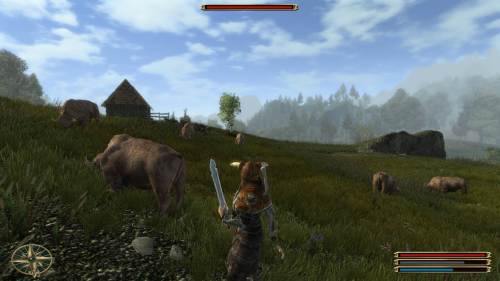
4. Mode of Exploration
This perhaps sounds like an unexpected point, but key to my pleasure of the game is how you explore it. A system that gives you an exact bearing on an exact map is no fun. Gothic 3 provides what seem to be old and inaccurate maps, lacking in detail. To explore and figure out where you are depends on endlessly climbing high points and trying to get your bearing. This closely reminds me of the times I spent exploring Scotland, where figuring out where you were was key. You can see a mountain, but once halfway up you lose vantage points and navigation can get hard. Gothic 3 re-captures something of this experience.
Further to this, exploration becomes a task in itself. If faced with a path or woodland that is to dangerous to traverse you might find that you needed to climb up a mountain or hill and find some elevated route to bypass the danger. Given the depth and complexity of the world the range of options is huge. You might find many possible paths through the mountains but many may not be viable, as they leave you with some impassible drop or precipice. This makes traversing the world a game in itself. In one instance I found the only option was to swim up a long river, as all other routes were too dangerous.
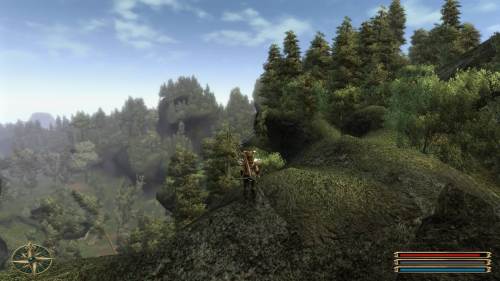
Net Quality of play
You can hit on all the star features, but the game could still be crud. The combination of attributes needs to keep you enthralled and engaged. That is not easy to quantify in Gothic 3, but is maybe illustrated by how the world actually plays out.
For a start, if you work hard enough, you can reach essentially all parts of the world. Nothing is passive scenery. By taking devious paths you can enter castles that you should be denied access to, dropping from overhanging rock and creeping along roofs.
If you try and play in pure "gaming" style you can find that the reality of the game trips you up. One such an example was when I had used a spell to charm a wolf to be my companion and fight for me. Pleased by this acquisition I wandered into a village, but the villagers immediately killed it. That kind of makes sense, as why would a real village welcome a wolf? It exposes something of the meaningful logic that imbues the world.
In my second pass through the world I found I could get people to do my dirty work for me by exploiting the natural hostility been factions and various entities within the world. Even the wildlife could be exploited: aggravating some hostile creature might allow it to be drawn to fight some other creature that blocked your path. When one won such combat, you could step in and finish off the remaining wounded creature, and then strip it of sellable horns etc.
There are so many such anecdotes I could quote here, where it required something close to some real world reasoning to determine what you could and could not do. This is a very immersive attribute.

Nearing the end of Play
After I recently realised that I had suggested I had been paying the current version of the game over 2 years I realised, from game saves, that this was actually over 4 years. I have stepped up play rate and still the richness presents new game issues and problems to be solved.
Starting revolutions was not as easy as I thought. I had found factions eager to consider local wars but when it came down to it they were reluctant. Getting all the conditions right could lead to very difficult tasks to solve. In one example I needed to contact a slave in the town to make sure we had their support, where I should have been a free agent. However my previous activities left me branded as a wanted man. The dance to get in and out of the town to reach the slave while staying alive was very challenging.
Again gaming expectations might lead you to imagine that problems could be constrained by distance. Gross hostility in one town one might imagine could be avoided by distance, but I found I was being hunted down across the entire world directly by the faction from within one town. Nowhere was safe and even friendly supportive groups that attempted to take on these hostile factions themselves in support ended up being wiped out, because I had lead my pursuers to them.
Again and again I found I was thinking about the Gothic world as if it might be real, looking for more real world than gaming solutions. Achieving a goal might be achieved by any quirky set of sub-solutions, leaving you feeling that your final solution might well be unique.
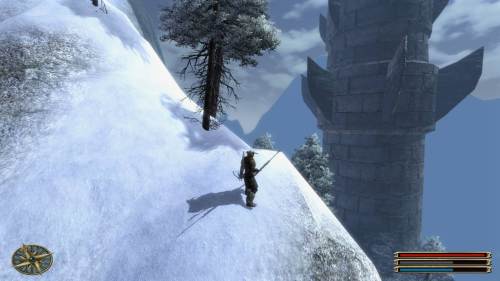
Conclusion
Gothic 3 hit the spot for me in a way that follow-ons, supposed to be enhanced better products, seemingly did not. I discarded 2 or 3 such spawned games that in theory were related games with better tech, but somehow they did not cut it.
Of course nothing is perfect and there are loopholes that the user can exploit that perhaps should not be there. A wounded creature or entity that is not winning an encounter really should run away, but they do not. That makes the game rather easier than it should be, so it could be better.
Gothic 3, for me, gets my vote as the best game I have ever played. I'm sure there must be better things out there, in which case I expect to be truly delighted in the future. In the meantime my highest regard goes to Piranha Bytes, and the Community patch group, for creating a totally absorbing and outstanding game.
LATE UPDATE! :) I eventually found the time to finish Gothic 3,and I have since tried my previously untested Gothic 3: Forsaken Gods - Enhanced Edition on my faster Windows 7 PC. This game shows modest improvements over Gothic 3, with better wildlife behaviour, so this amends my entry remarks in the section. I also picked up and tested a few other RPG titles, including the now slightly old Skyrim, but have elected instead to play Forsaken Gods. The latter lacks some key elements such as reputation building, so its main appeal will be for those who have already completed Gothic 3 and want to further the same adventure in a world that has evolved. It has to be said that the quests are less engaging and even some bugs.
From reviews you will see that either people love or hate the Gothic 3 genre. If you want to be some powerful hero protected against failure by the game mechanics then other titles might suit you better. In the Gothic 3 genre even the most lowly hostile creature might kill you in the first 5 minutes of play. There is no protection and you can even easily find you have killed characters that stop quests being possible. Gothic 3 is for the more gritty RPG player ready to fight their way is what is the most open RPG title around.
For those taking the step the default settings probably needed tweaks (use Bloom, not HDR), and tweaks to GE3.ini to allow entities to be seen sooner etc. Also switch off the text pop-ups in the audio section.
I should also reference reader to the following: "Gothic 3 - Why it's my Favorite Game of all Time!". This more comprehensive and overall an insightful look than my short review and has the advantage of a walkthrough. You may or may not like the presentation style but his dissection of the essential character and uniqueness of this very special game is pretty spot on.
Jeff Rollason - December 2015
